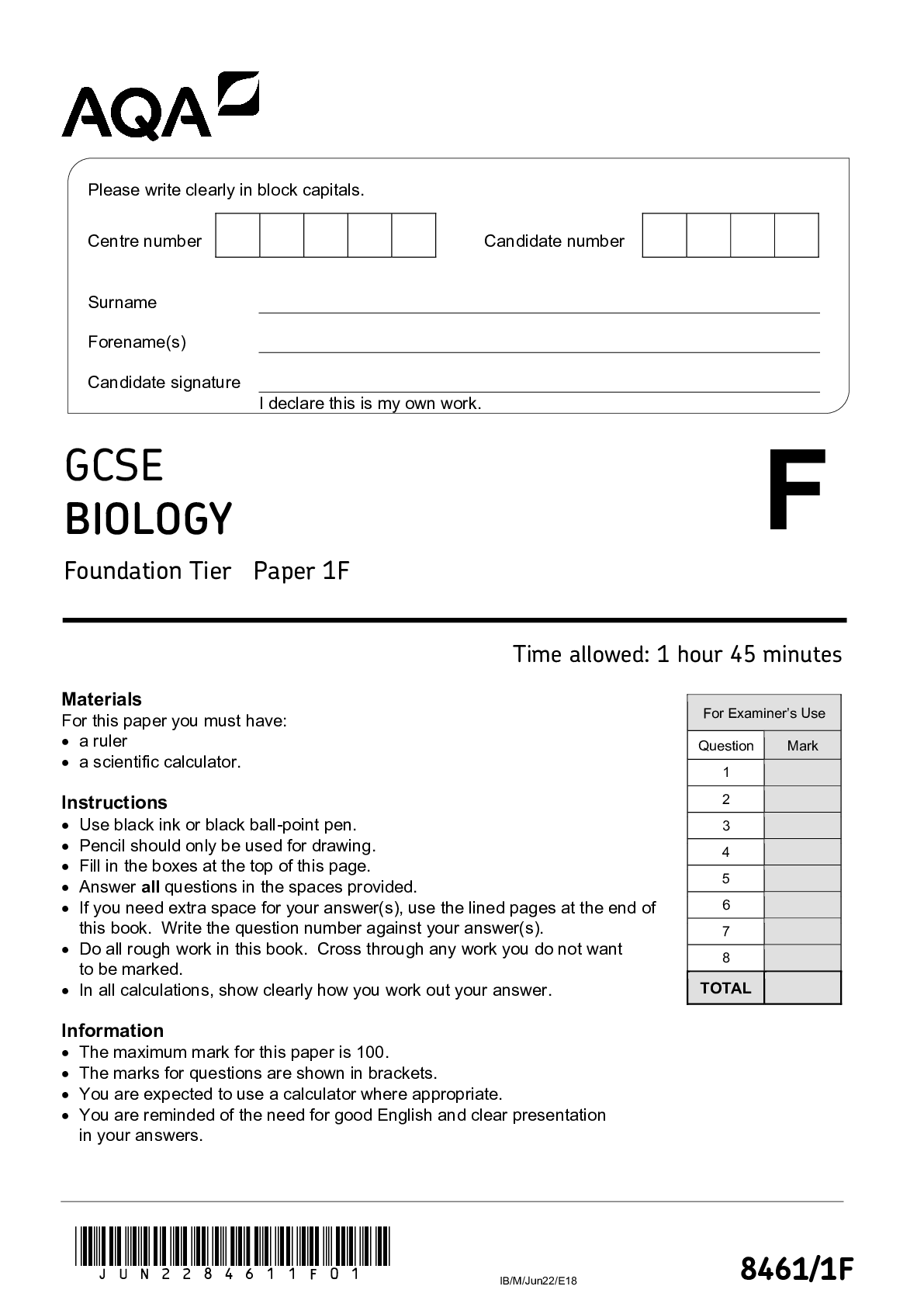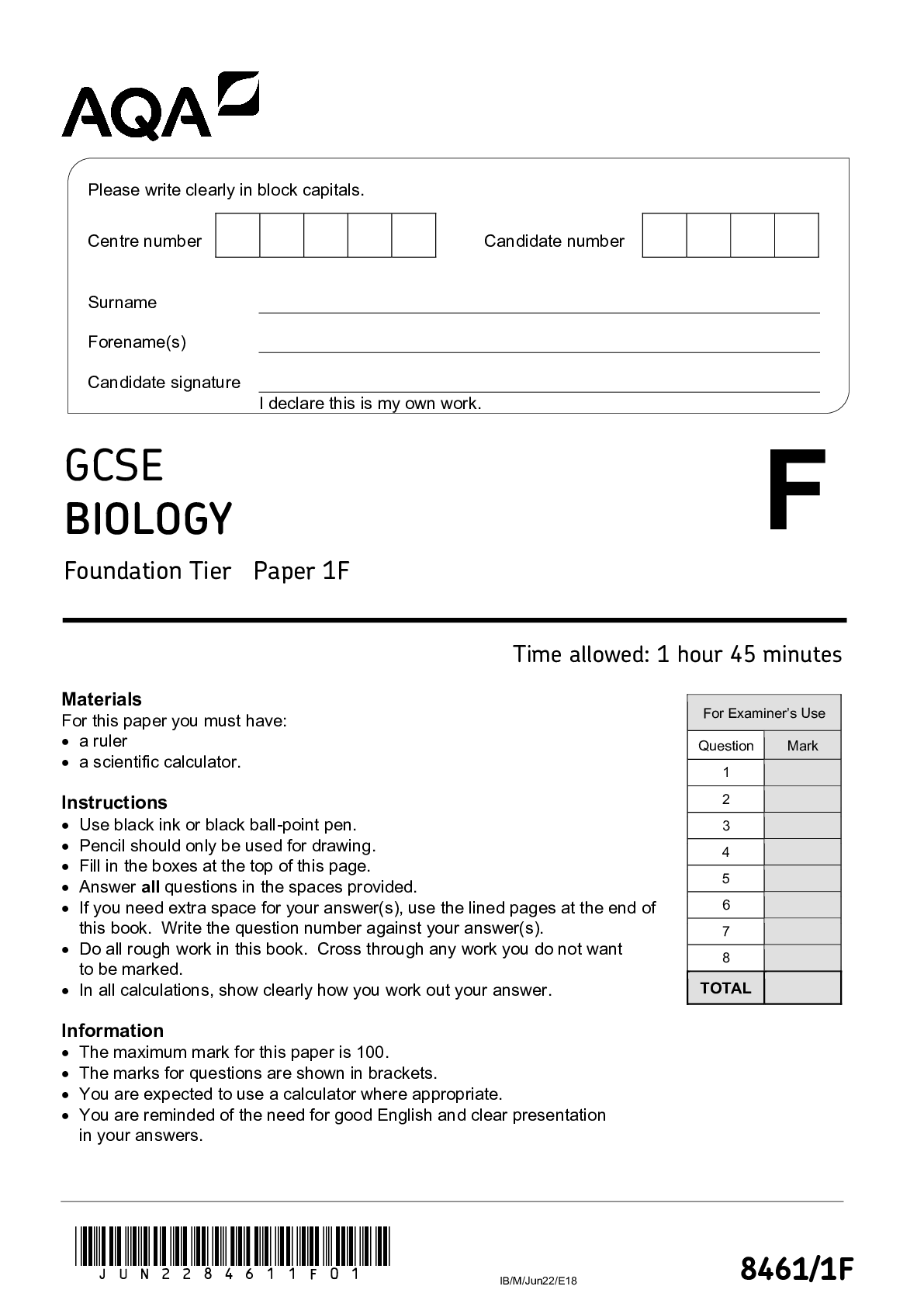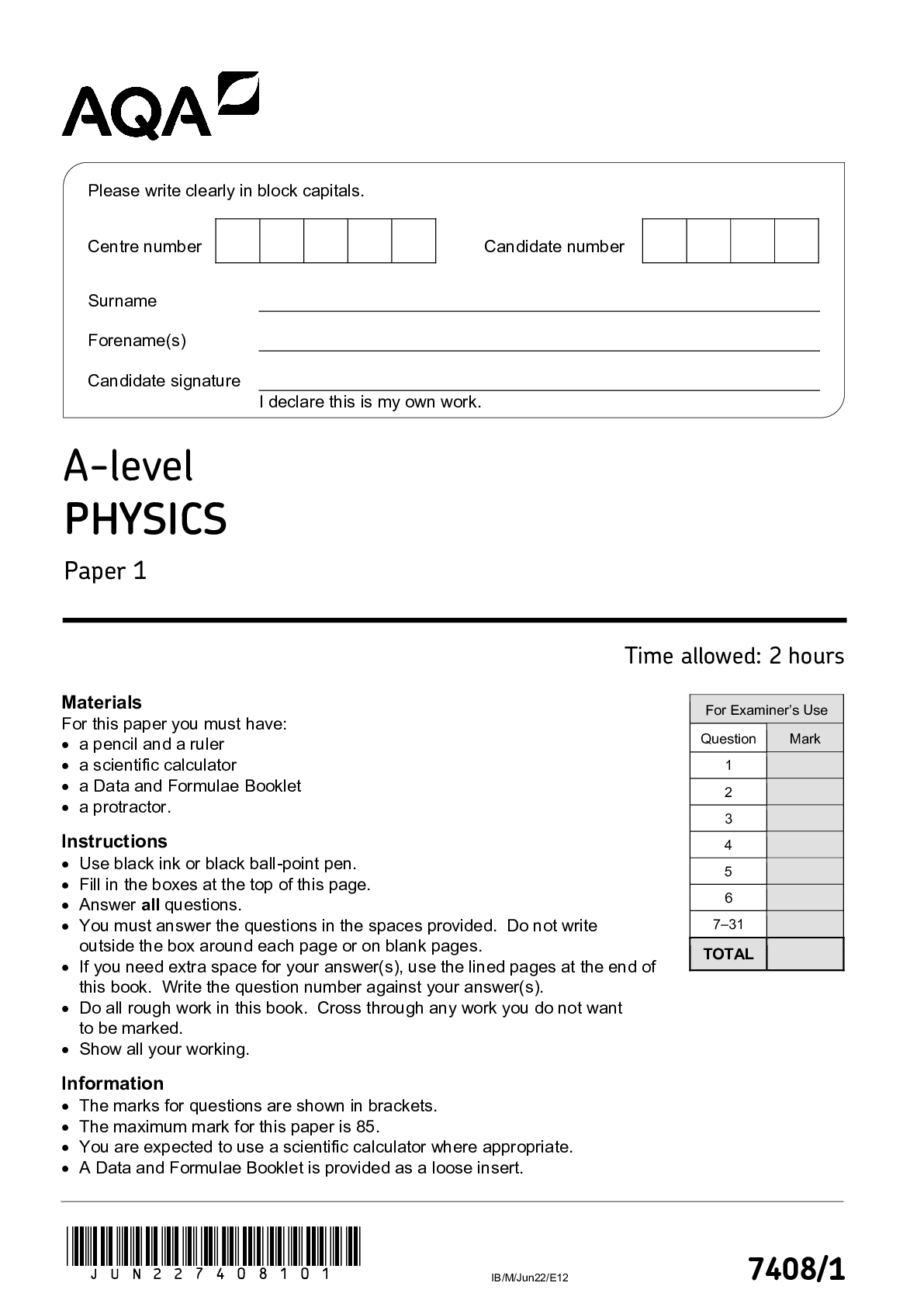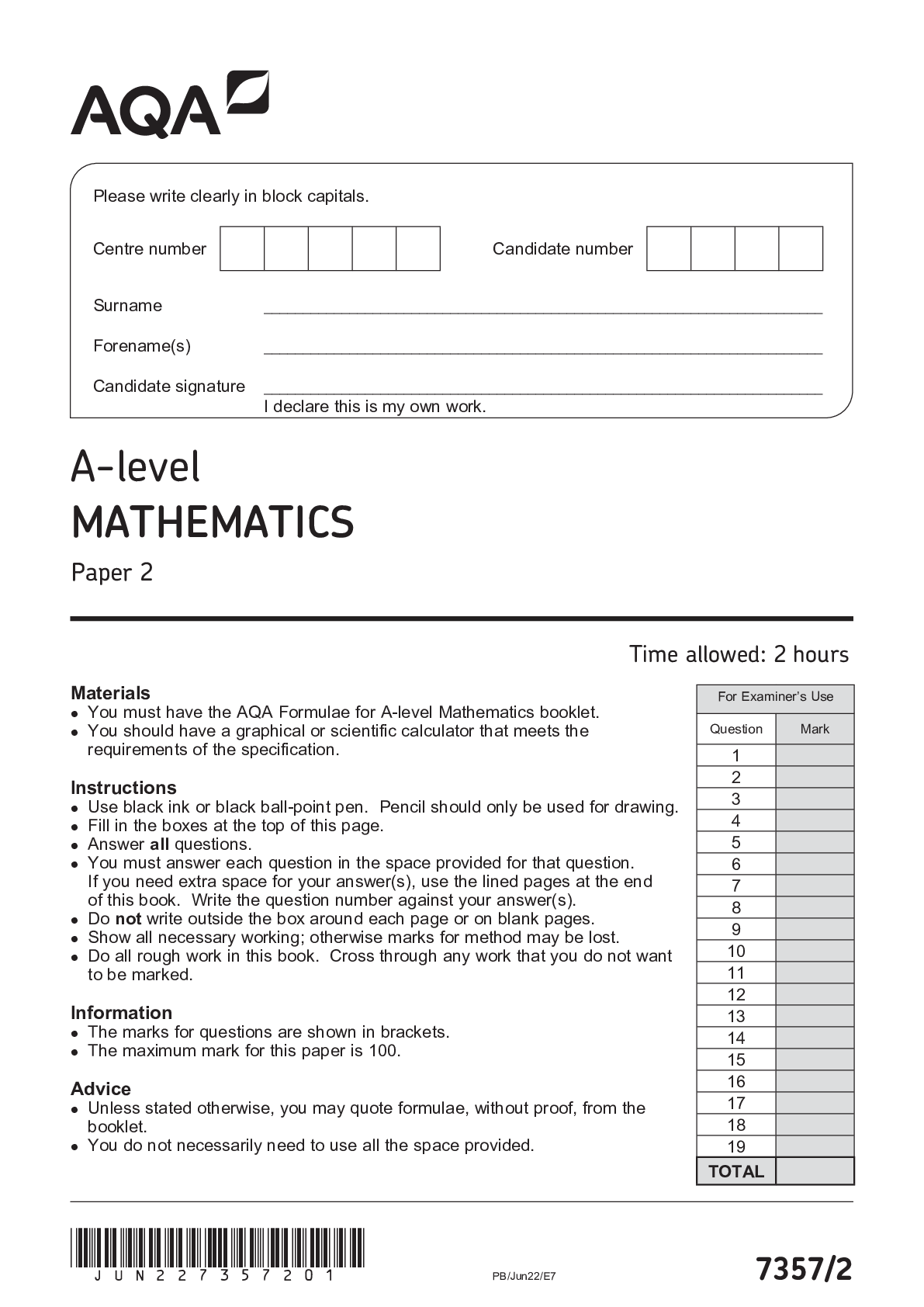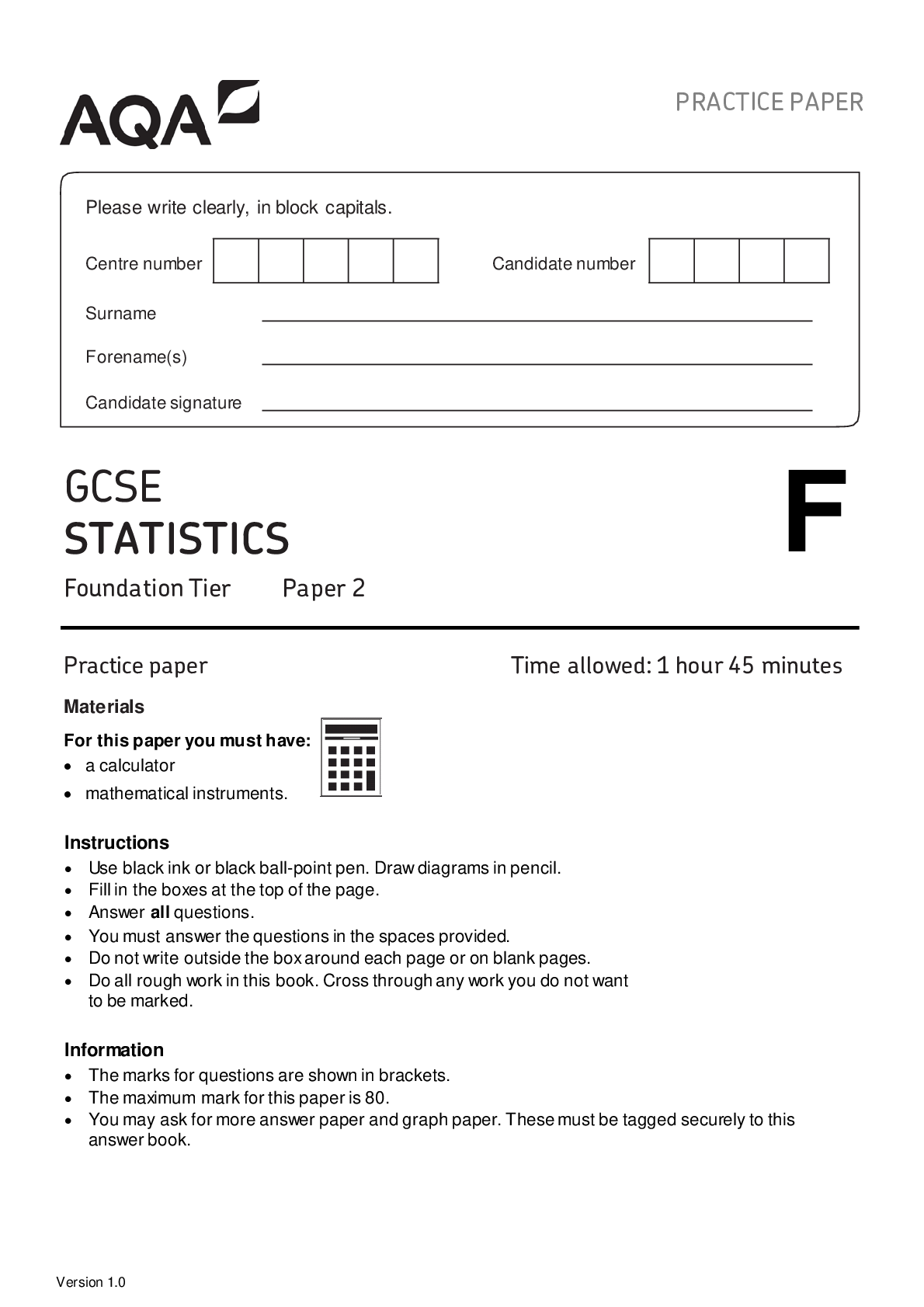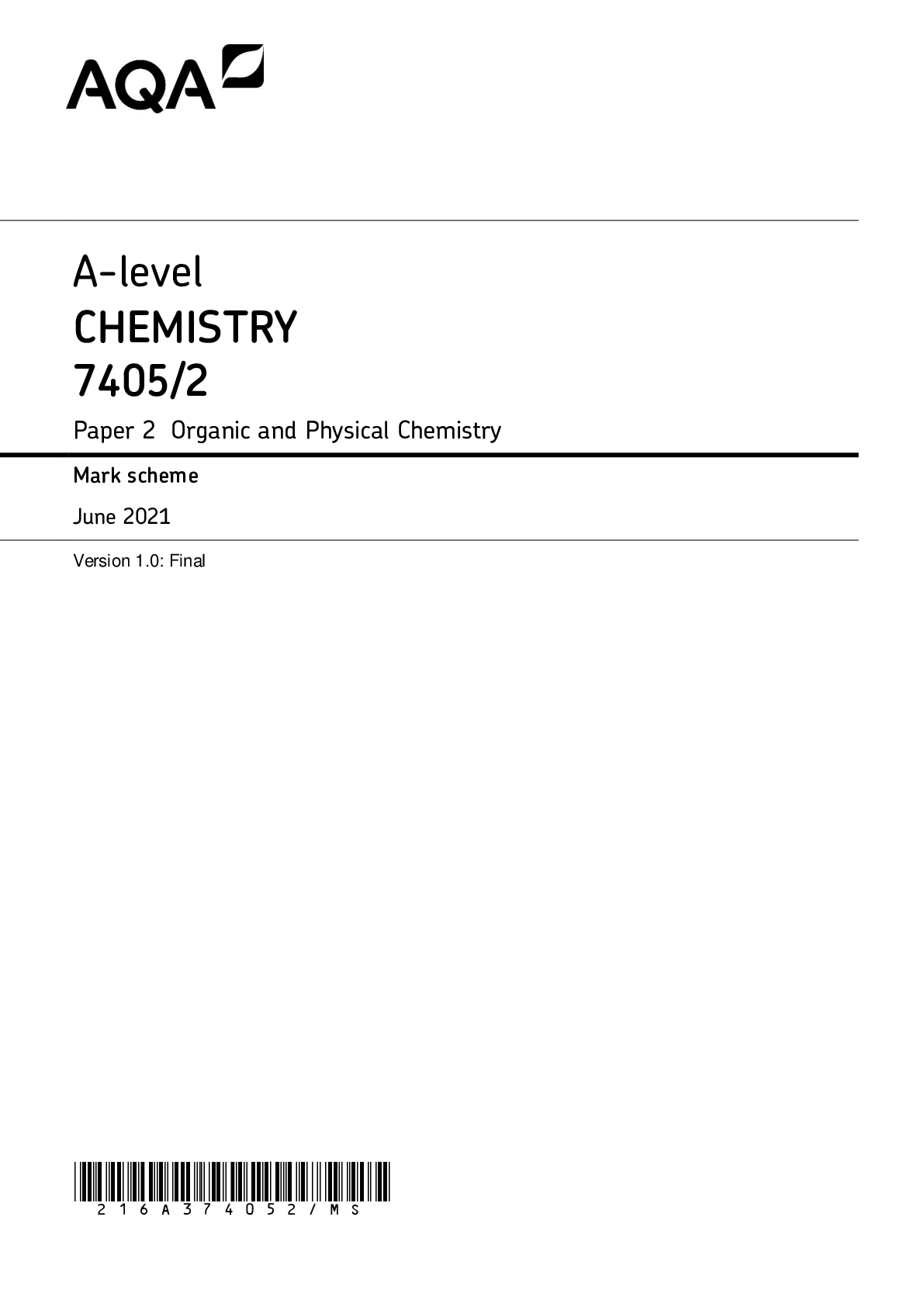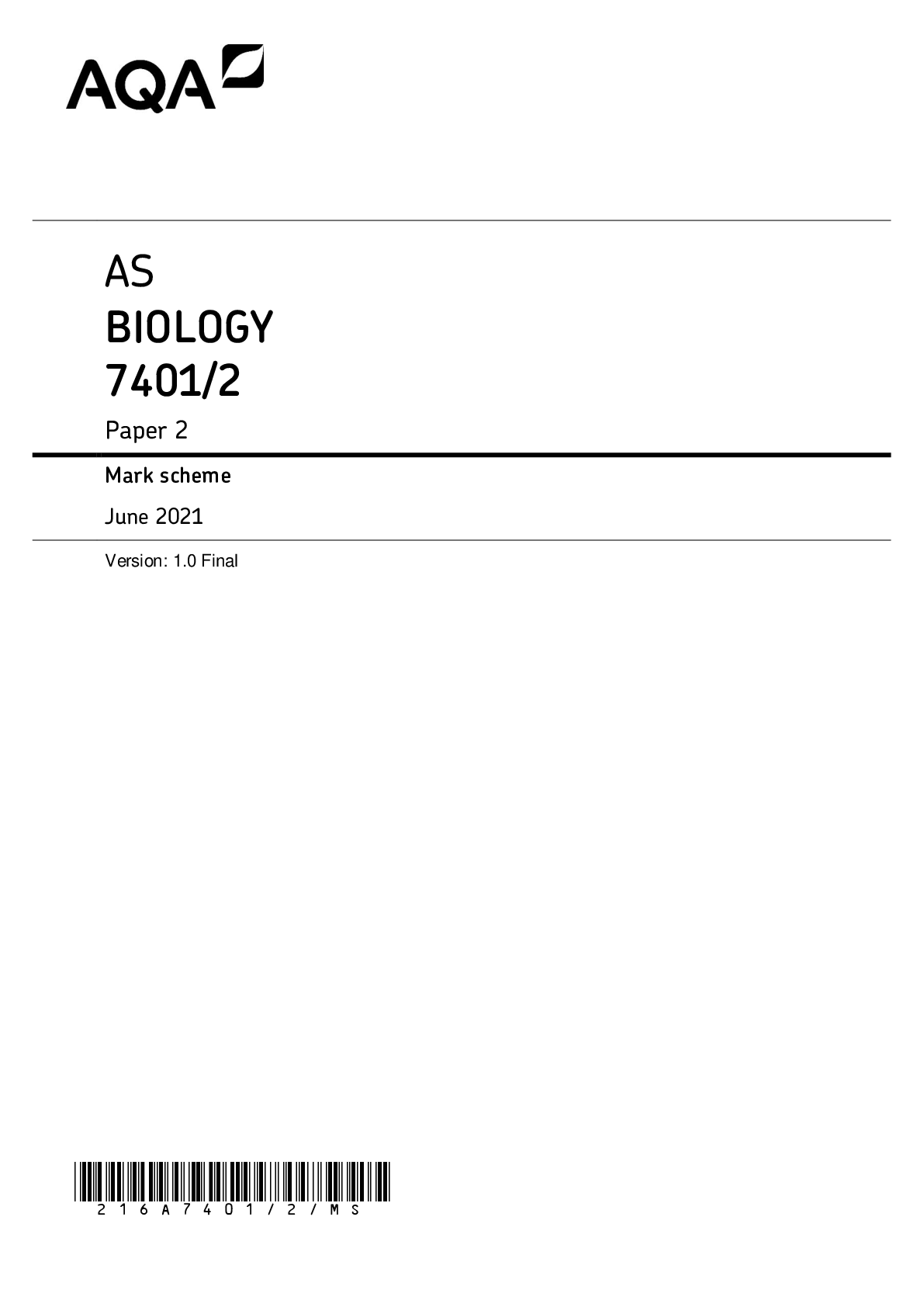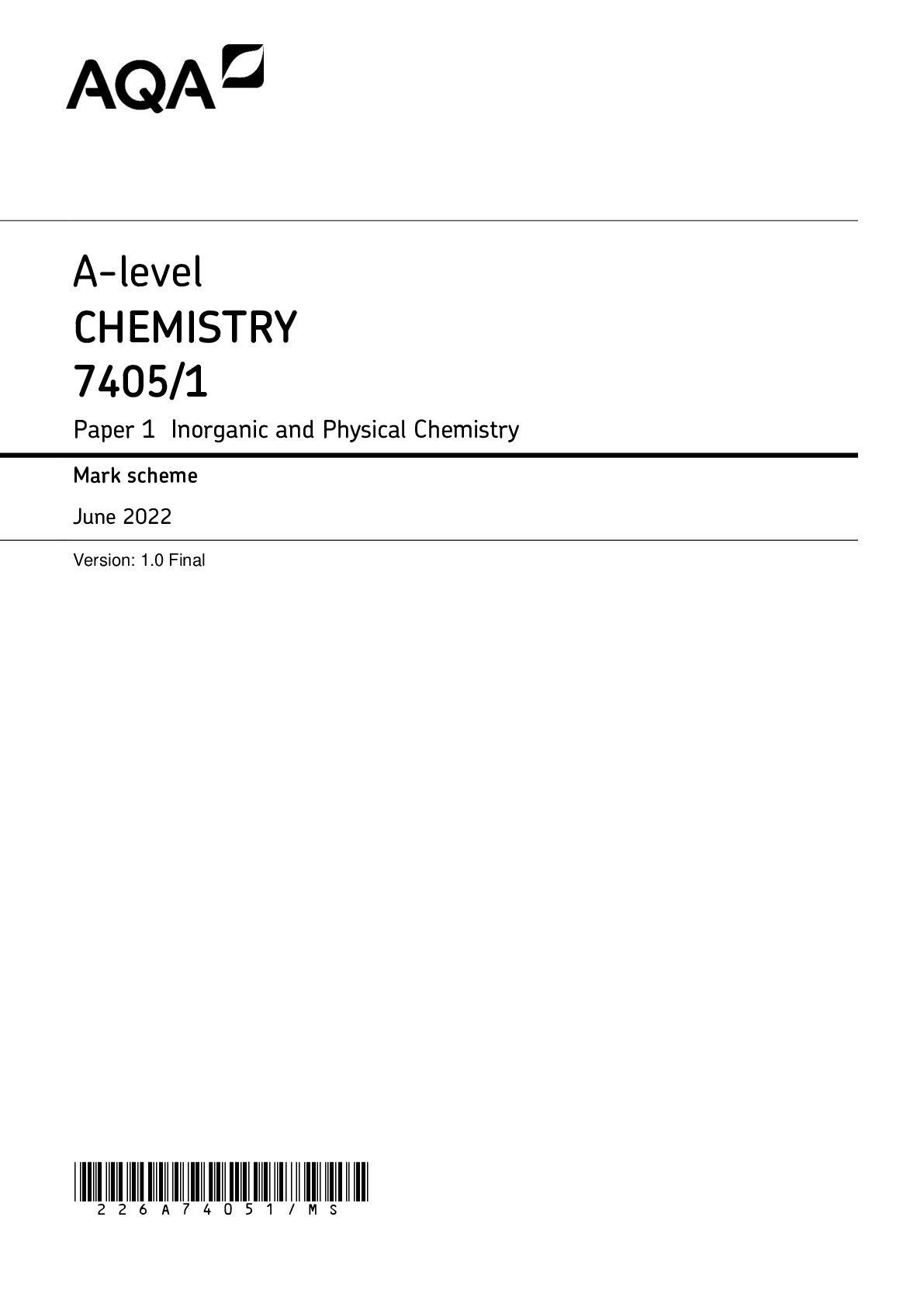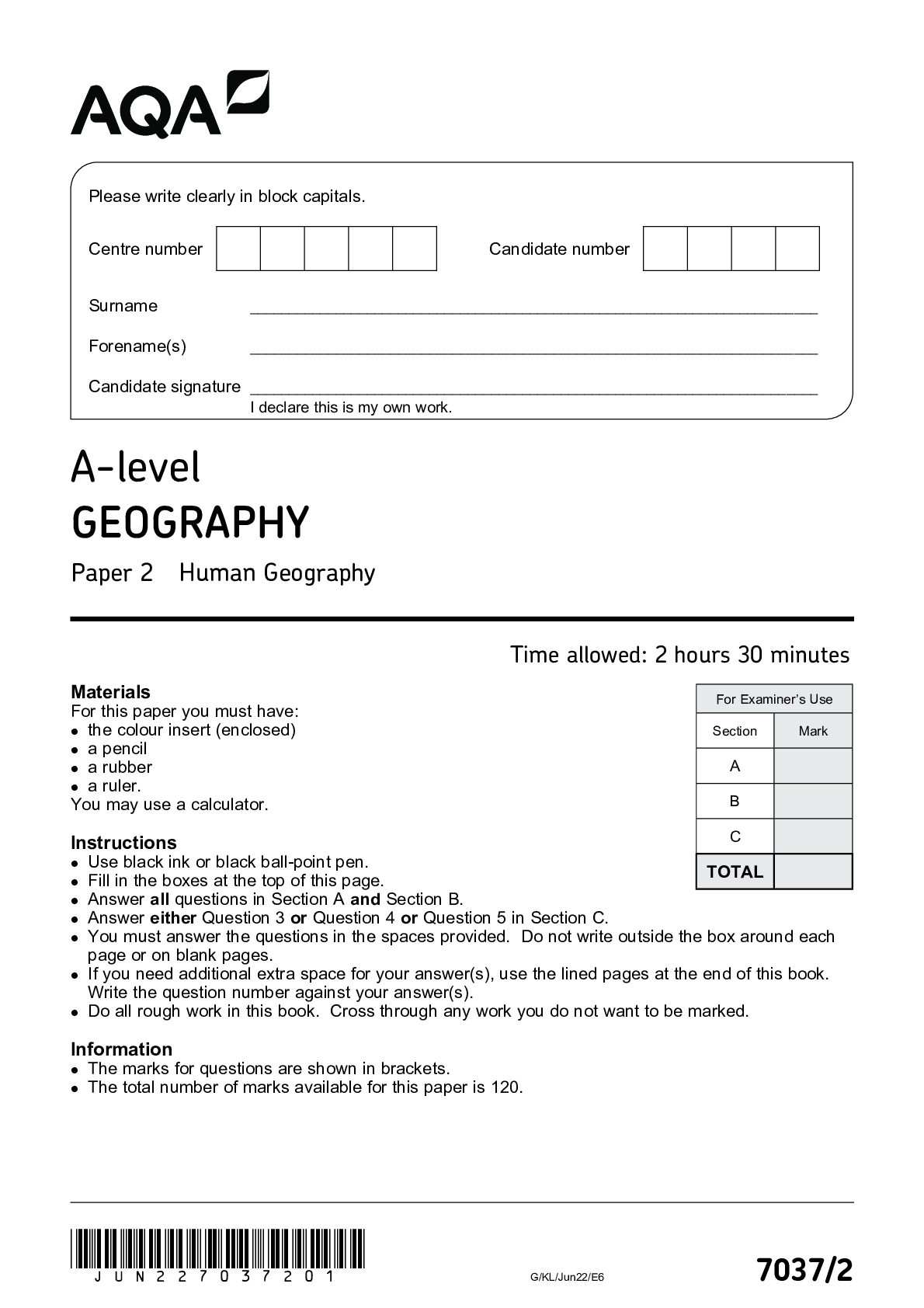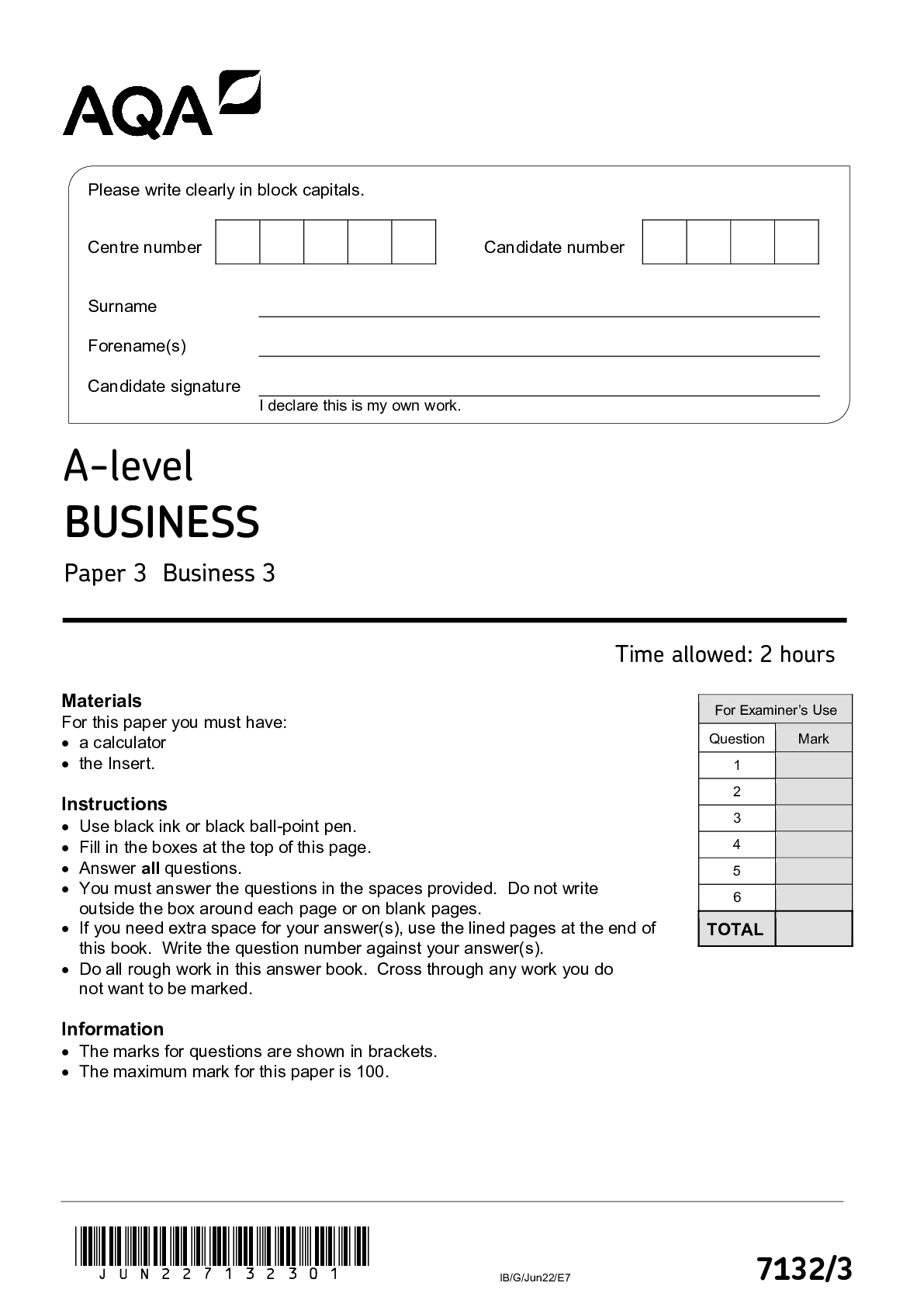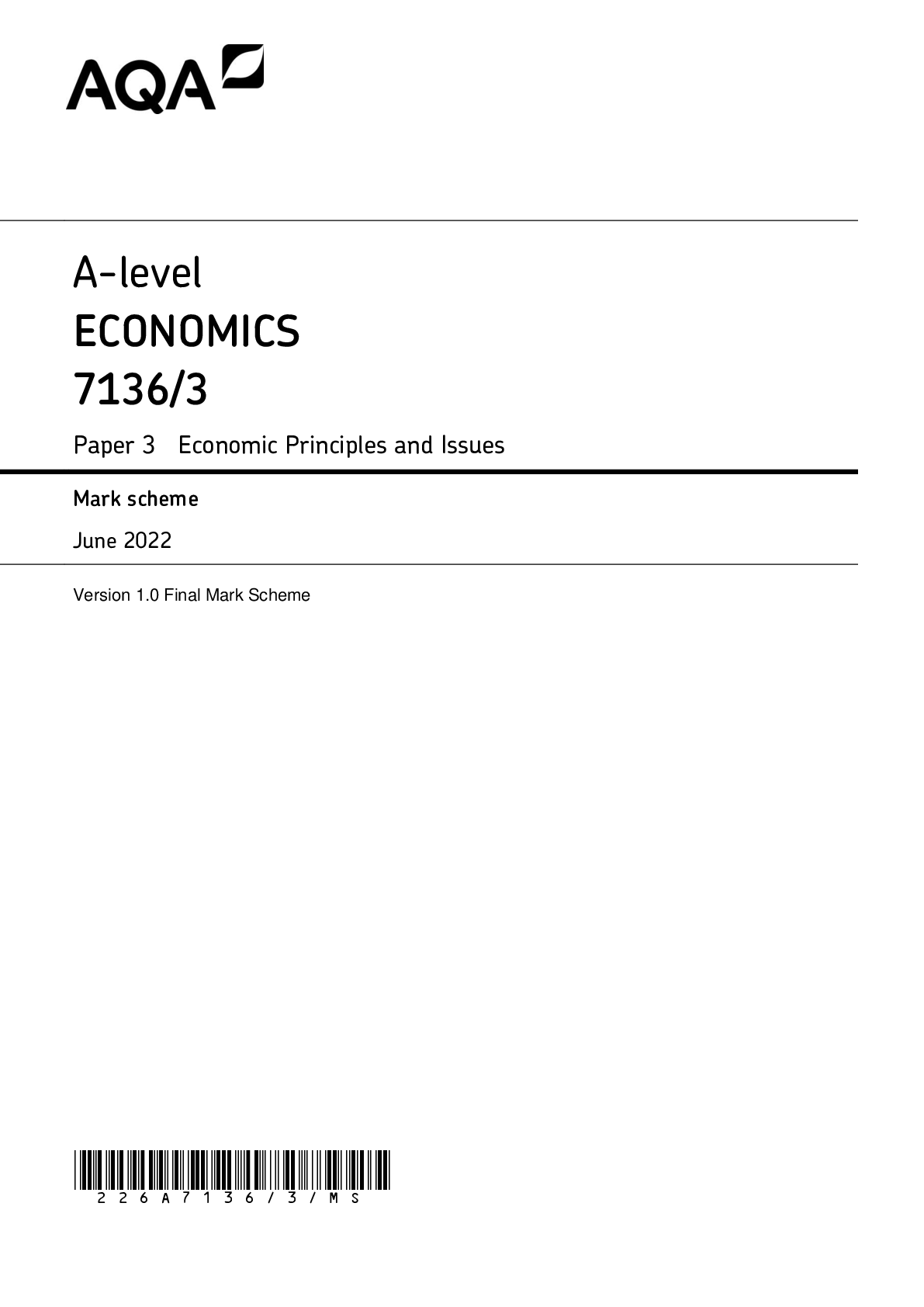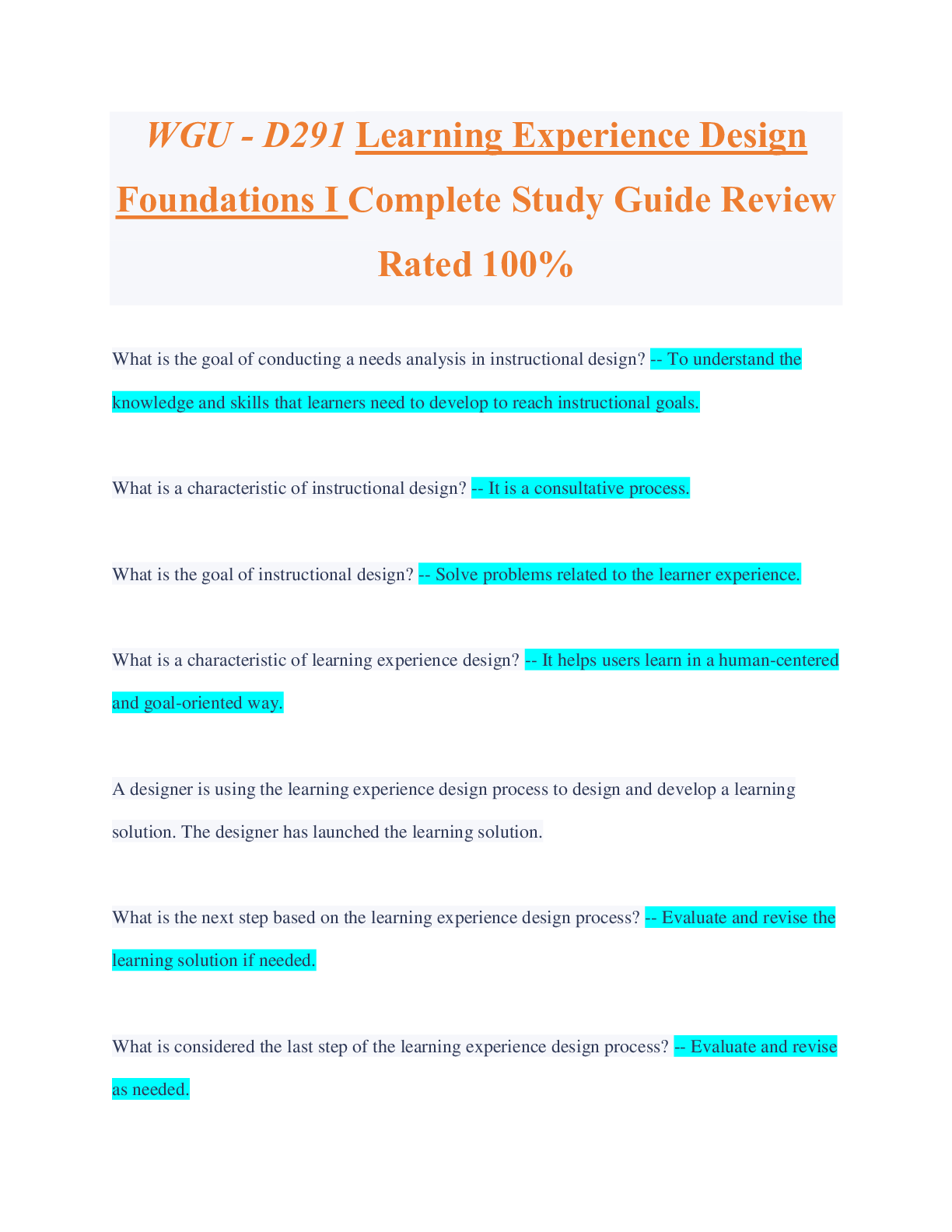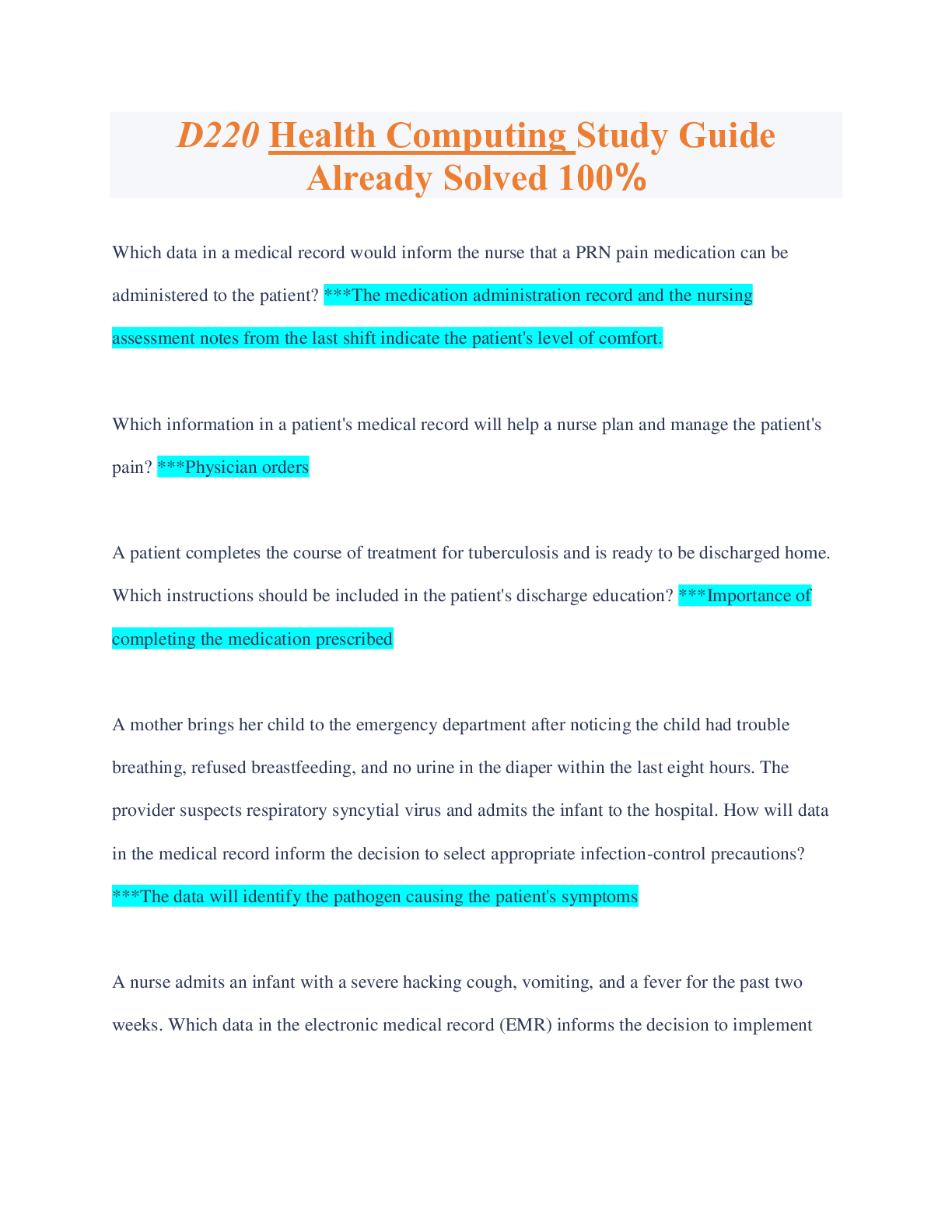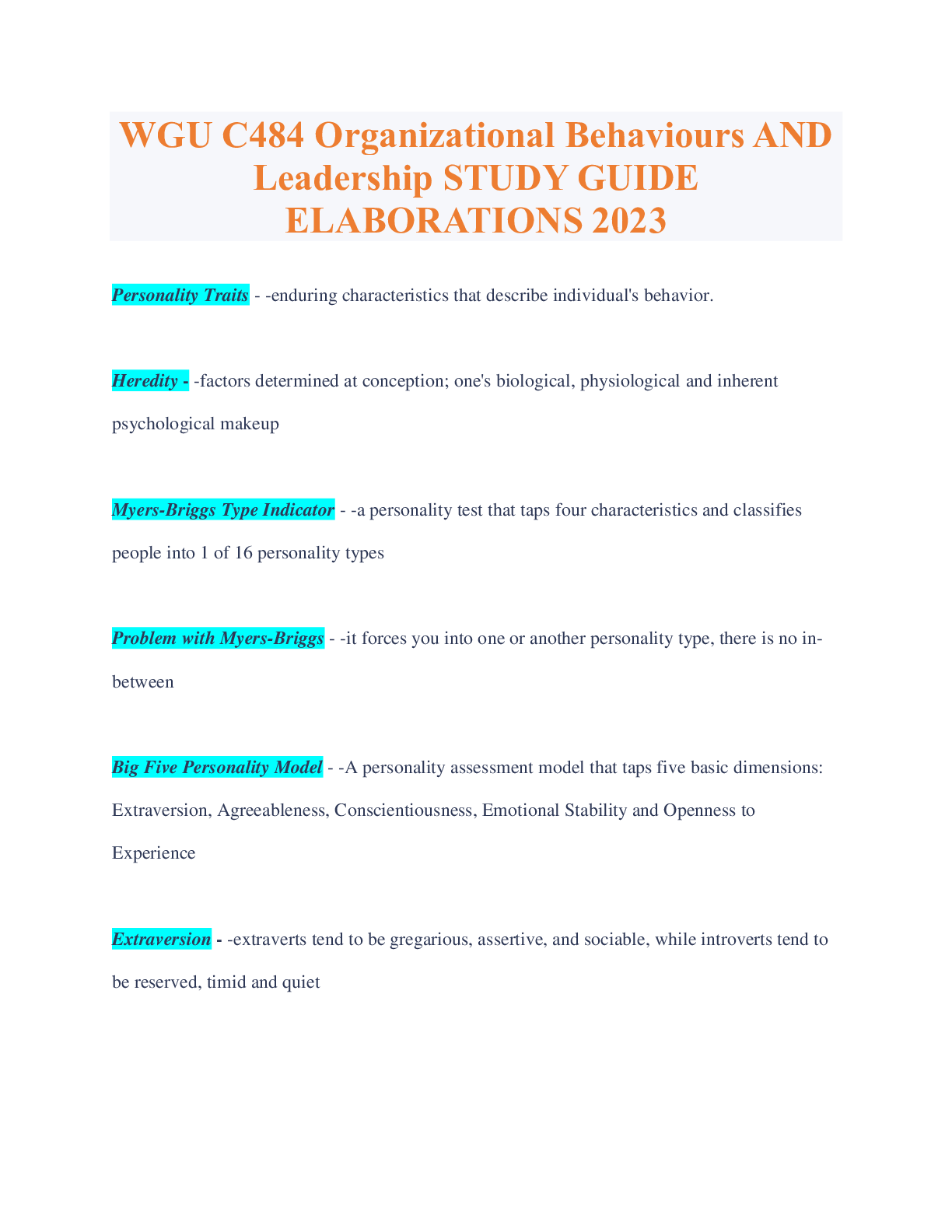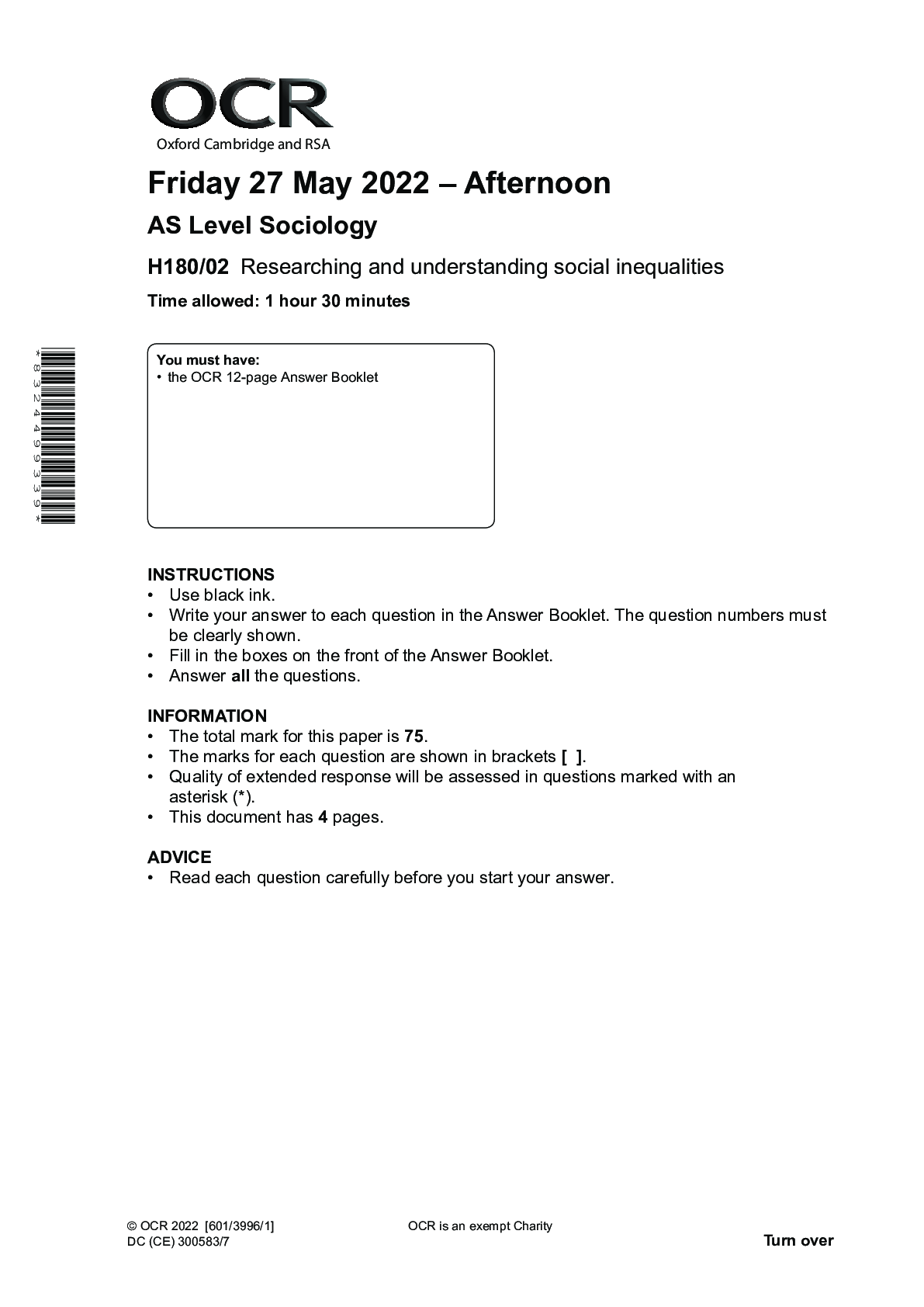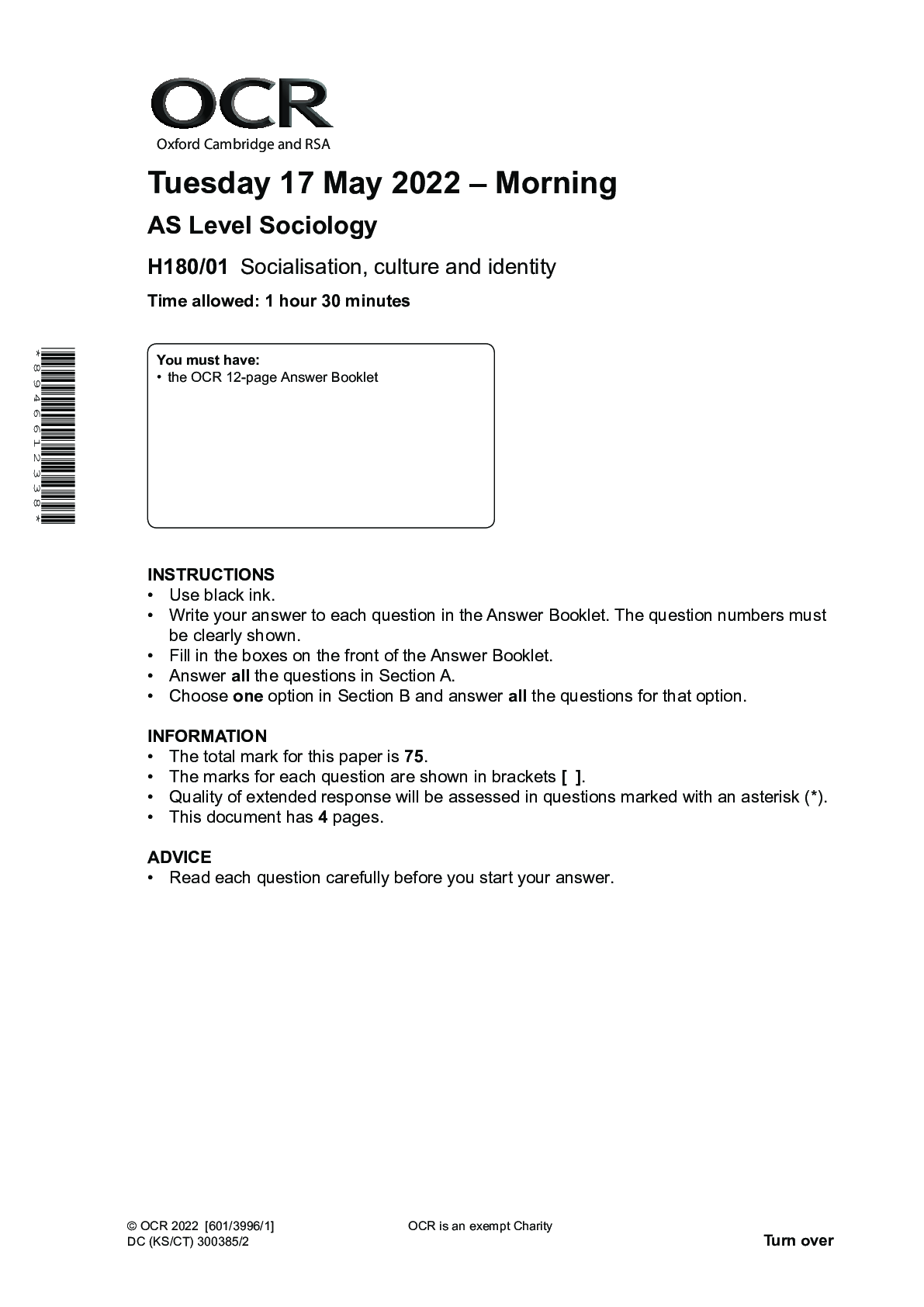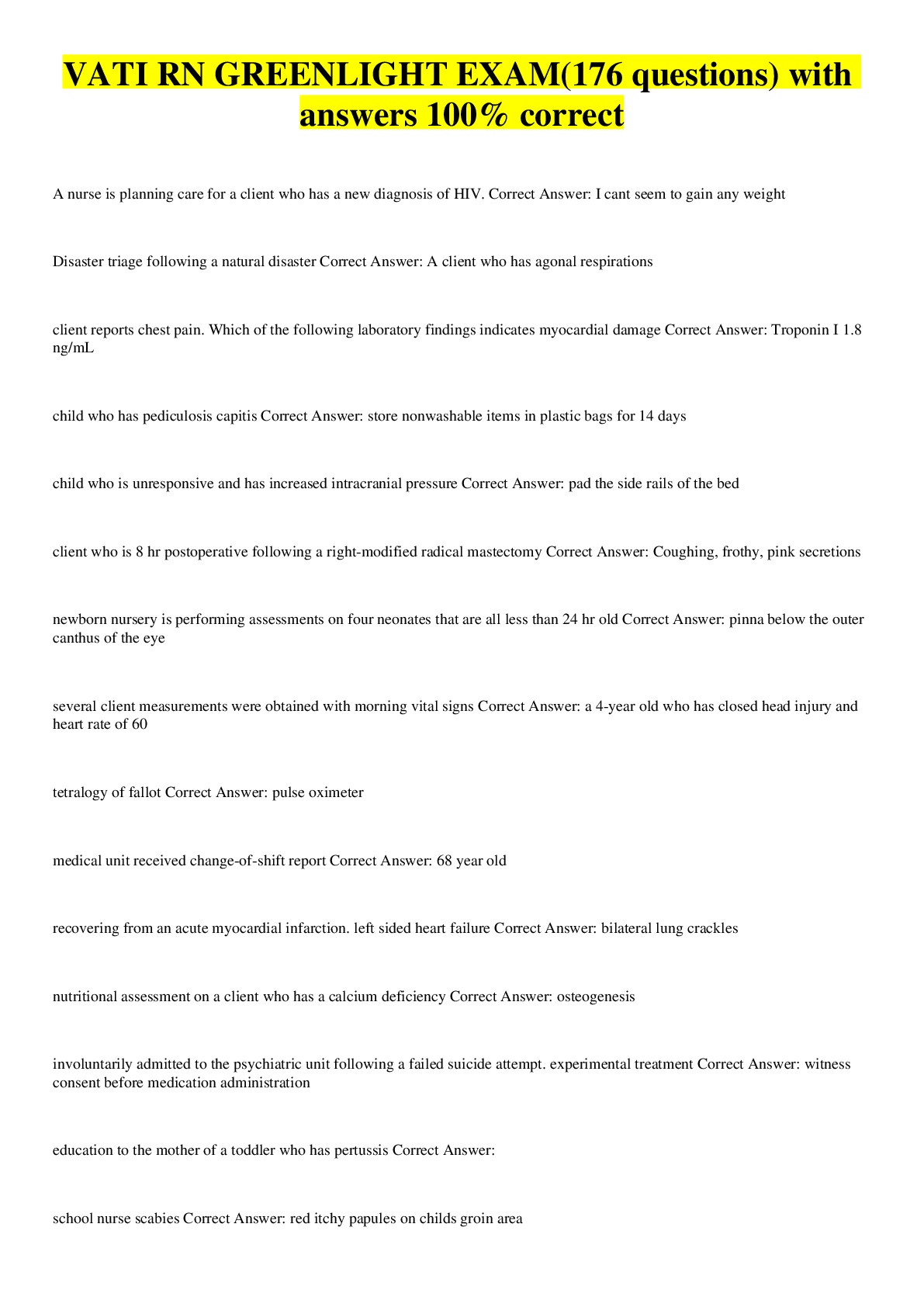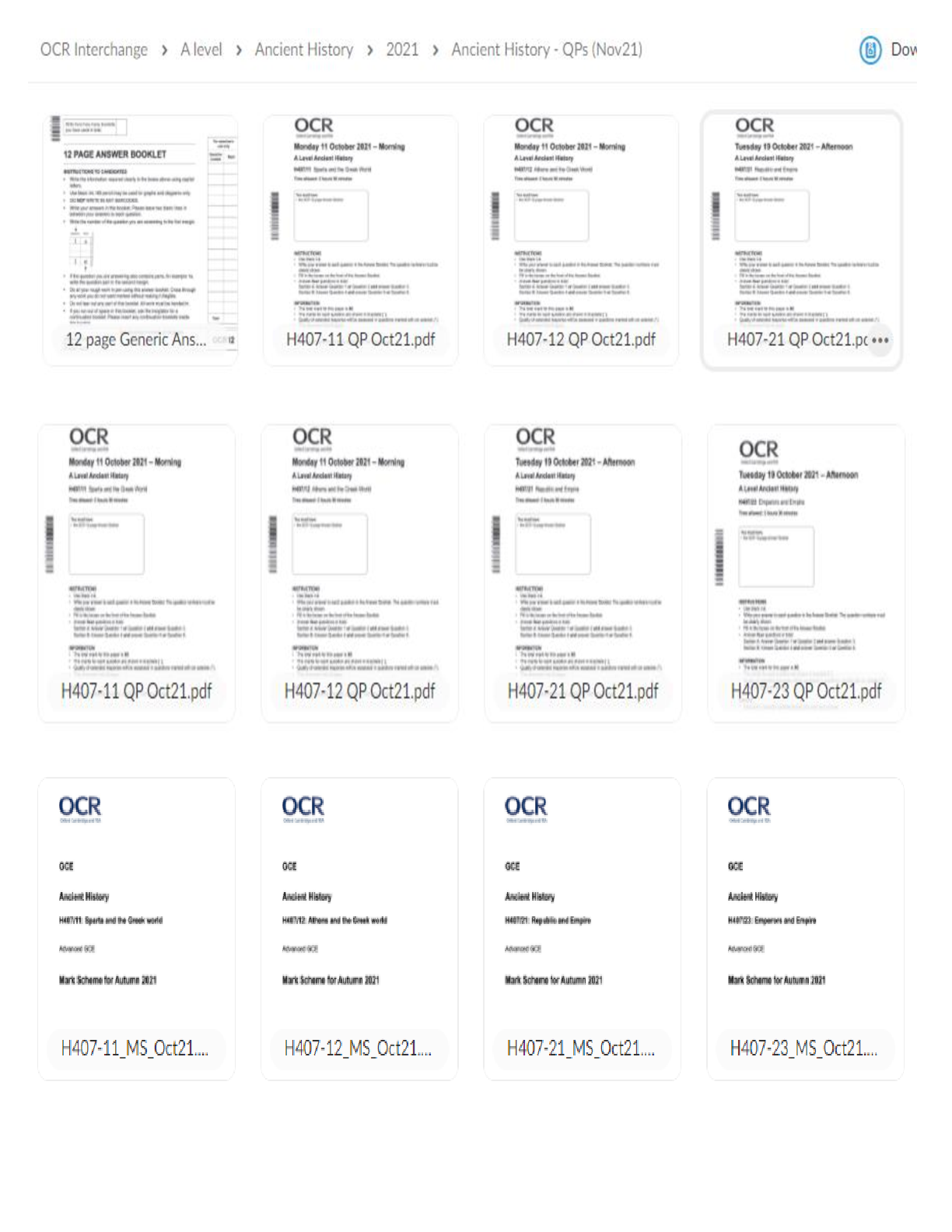Business > AQA A/As Level Question Paper > AQA A-level BUSINESS 7132/3 Paper 3 Business 3 Mark scheme June 2022 Version: 1.0 Final (All)
AQA A-level BUSINESS 7132/3 Paper 3 Business 3 Mark scheme June 2022 Version: 1.0 Final
Document Content and Description Below
A-level BUSINESS 7132/3 Paper 3 Business 3 Mark scheme June 2022 Version: 1.0 Final *226A7132/3/MS* MARK SCHEME – A-LEVEL BUSINESS – 7132/3 – JUNE 2022 2 Mark schemes are prepared by ... the Lead Assessment Writer and considered, together with the relevant questions, by a panel of subject teachers. This mark scheme includes any amendments made at the standardisation events which all associates participate in and is the scheme which was used by them in this examination. The standardisation process ensures that the mark scheme covers the students’ responses to questions and that every associate understands and applies it in the same correct way. As preparation for standardisation each associate analyses a number of students’ scripts. Alternative answers not already covered by the mark scheme are discussed and legislated for. If, after the standardisation process, associates encounter unusual answers which have not been raised they are required to refer these to the Lead Examiner. It must be stressed that a mark scheme is a working document, in many cases further developed and expanded on the basis of students’ reactions to a particular paper. Assumptions about future mark schemes on the basis of one year’s document should be avoided; whilst the guiding principles of assessment remain constant, details will change, depending on the content of a particular examination paper. Further copies of this mark scheme are available from aqa.org.uk Copyright information AQA retains the copyright on all its publications. However, registered schools/colleges for AQA are permitted to copy material from this booklet for their own internal use, with the following important exception: AQA cannot give permission to schools/colleges to photocopy any material that is acknowledged to a third party even for internal use within the centre. Copyright © 2022 AQA and its licensors. All rights reserved. MARK SCHEME – A-LEVEL BUSINESS – 7132/3 – JUNE 2022 3 Level of response marking instructions Level of response mark schemes are broken down into levels, each of which has a descriptor. The descriptor for the level shows the average performance for the level. There are marks in each level. Before you apply the mark scheme to a student’s answer read through the answer and annotate it (as instructed) to show the qualities that are being looked for. You can then apply the mark scheme. Step 1 Determine a level Start at the lowest level of the mark scheme and use it as a ladder to see whether the answer meets the descriptor for that level. The descriptor for the level indicates the different qualities that might be seen in the student’s answer for that level. If it meets the lowest level then go to the next one and decide if it meets this level, and so on, until you have a match between the level descriptor and the answer. With practice and familiarity you will find that for better answers you will be able to quickly skip through the lower levels of the mark scheme. When assigning a level you should look at the overall quality of the answer and not look to pick holes in small and specific parts of the answer where the student has not performed quite as well as the rest. If the answer covers different aspects of different levels of the mark scheme you should use a best fit approach for defining the level and then use the variability of the response to help decide the mark within the level, ie if the response is predominantly level 3 with a small amount of level 4 material it would be placed in level 3 but be awarded a mark near the top of the level because of the level 4 content. Step 2 Determine a mark Once you have assigned a level you need to decide on the mark. The descriptors on how to allocate marks can help with this. The exemplar materials used during standardisation will help. There will be an answer in the standardising materials which will correspond with each level of the mark scheme. This answer will have been awarded a mark by the Lead Examiner. You can compare the student’s answer with the example to determine if it is the same standard, better or worse than the example. You can then use this to allocate a mark for the answer based on the Lead Examiner’s mark on the example. You may well need to read back through the answer as you apply the mark scheme to clarify points and assure yourself that the level and the mark are appropriate. Indicative content in the mark scheme is provided as a guide for examiners. It is not intended to be exhaustive and you must credit other valid points. Students do not have to cover all of the points mentioned in the Indicative content to reach the highest level of the mark scheme. An answer which contains nothing of relevance to the question must be awarded no marks. MARK SCHEME – A-LEVEL BUSINESS – 7132/3 – JUNE 2022 4 Marking guidance • Be clear on the focus of the question. • Read the response as a whole; follow the flow of the argument as a whole. • Remember that the indicative content provides possible lines of argument but there may be others that are equally valid. Be willing to credit other lines of argument. • Annotate the script as you read in accordance with the instructions given at standardisation. • Consider what it all adds up to, eg is this a limited response? A reasonable one? A good one? Refer back to the standardisation scripts and guidance to help you benchmark. You are marking to the standard agreed at standardisation. Be careful of the standard you are marking at; refer back to standardisation scripts regularly. • Summarise your findings briefly at the end of the response. This will help you decide on the overall level and is helpful for others to understand the mark given, eg for an extended response ‘well-argued’ but does not focus fully on the issue of ‘long term’ feels as if it might be good rather than excellent. Make sure the comments fit with the level awarded: ‘unbalanced and not comparing with alternative solutions’ does not sound as if it is ‘good’. • Next to your comment put the level awarded, eg L4. • If in doubt about an approach contact your Team Leader, do not make up your own rules because we must have a standardised approach across all marking. • Be positive in your marking. Look to reward what is there. Annotations Key KU Knowledge and understanding – used to credit knowledge of the specification and also to acknowledge ‘points’ made in relation to the question, perhaps explained, but once the point has some analytical dev, annotate AN or ARG Bal Balanced response, eg both sides acknowledged with at least a valid ARG on either side AN Analytical but lacks context, ie a theoretical line of argument ARG Argument (analysis in context) DP Developed argument (well-developed analysis in context) Rng Range of arguments, ie two ARGs presented J Judgement with support Q? Losing/lost focus – not fully focused on the demands of the question BD Benefit of doubt – though there is some uncertainty over the student’s meaning, the point or aspect of the argument will be accepted as creditworthy NR Not relevant – ie not answering the question – response has drifted from answering the question set. When using, be sure to read the whole response carefully – students will often drift back to answering the question later in their response – normal annotation should resume whenever they come back to addressing the demands of the question O Own figure rule – to be annotated where a valid argument develops following a miscalculation (ie a wrong answer is used correctly) SEEN Used to show work has been read but contains nothing creditworthy – please check carefully (See NR) Tick ONLY used to show a correct calculation – please use KU when annotating valid points Cross To show an incorrect calculation or a clearly incorrect link in a chain of logic – if in doubt, do not cross, use BD ? Meaning unclear R Repetition Eval Indicates valid evaluation within the response NFF Not Fully Focused - retains some relevance to the question asked but not fully focused on the specific question asked MARK SCHEME – A-LEVEL BUSINESS – 7132/3 – JUNE 2022 5 0 1 Analyse the factors affecting SSN Ltd’s promotional decisions. [12 marks] Marks for this question: AO1 = 3, AO2 = 3, AO3 = 6 Level The student will typically demonstrate: Marks 3 A good response overall that focuses on many of the demands of the question. Provides an answer to the question set that: • demonstrates a depth and range of knowledge and understanding of issues in the question • demonstrates analysis which is well developed, applied effectively to the context and considers a range of issues in the question. 9–12 2 A reasonable response overall that focuses on some of the demands of the question. Provides an answer to the question set that: • demonstrates a limited knowledge and understanding of a range of issues in the question or a good knowledge and understanding of relatively few issues in the question • demonstrates analysis which is developed, applied to the context and considers some of the issues in the question. 5–8 1 A limited response overall with little focus on the demands of the question. Provides an answer to the question set that: • demonstrates a limited range and depth of knowledge and understanding of issues in the question • demonstrates analysis with little development and mainly descriptive application to the context. 1–4 The demands of this question are: • analyse factors affecting promotional decisions • link these to aspect(s) of SSN Ltd’s context. Indicative content: • B2B – focus on target market of decision-makers in large businesses – so promotional channels must be able to reach these. Appendix B shows methods that may achieve this. • An image of trustworthiness and reliability will be key in this market which may rely on creating an image of being a large established business – which could explain sponsorship as a means of pushing the company’s wider reputation. This will also affect messaging behind promotional activities. • Online only – not likely to mean only online channels should be used – note the relative importance of personal selling. • Focus on large businesses as customers probably increases the amount that needs to be spent on promotion, in order to access channels that will reach decision-makers within these companies. • Bemi majority owns and controls the business – therefore her say is likely to override the opinions of others in making promotional decisions. • The product’s position on the Boston Matrix (probably a star, with high share of a high growth market) suggests heavy promotional spending will be needed to protect market share in a market that will be attractive to new entrants. • Finance available – SSN Ltd is short of cash and heavily indebted – therefore budgetary constraints are likely to influence the promotional methods chosen MARK SCHEME – A-LEVEL BUSINESS – 7132/3 – JUNE 2022 6 • Promotional decisions may consider both methods of promotion used and the message behind the promotional activities. Accept other relevant arguments NOTE: One factor with well-developed analysis applied effectively to the context should score 9 marks MARK SCHEME – A-LEVEL BUSINESS – 7132/3 – JUNE 2022 7 0 2 Analyse how copyright may have been important to the growth of SSN Ltd. [12 marks] Marks for this question: AO1 = 3, AO2 = 3, AO3 = 6 Level The student will typically demonstrate: Marks 3 A good response overall that focuses on many of the demands of the question. Provides an answer to the question set that: • demonstrates a depth and range of knowledge and understanding of issues in the question • demonstrates analysis which is well developed, applied effectively to the context and considers a range of issues in the question. 9–12 2 A reasonable response overall that focuses on some of the demands of the question. Provides an answer to the question set that: • demonstrates a limited knowledge and understanding of a range of issues in the question or a good knowledge and understanding of relatively few issues in the question • demonstrates analysis which is developed, applied to the context and considers some of the issues in the question. 5–8 1 A limited response overall with little focus on the demands of the question. Provides an answer to the question set that: • demonstrates a limited range and depth of knowledge and understanding of issues in the question • demonstrates analysis with little development and mainly descriptive application to the context. 1–4 The demands of this question are: • show a clear understanding of the importance of protecting intellectual property • analyse the importance of copyright in SSN Ltd’s growth. Indicative content: • once SSN started to grow, copyright will have ensured that larger, established rivals could not directly copy its systems – protecting the business from these bigger rivals while it grew • SSN Ltd has an effective monopoly over this piece of technology – this may allow it to attract large customers desperate to use this system – boosting total sales rapidly • if clients can be convinced this unique service is exactly what they need, these clients will find it hard to move elsewhere – enabling the business to retain most customers it attracts • insulation from direct competition could allow relatively low advertising costs freeing funding for other aspects of growth • the company have a USP that can be used in promoting the service – allowing it to attract new customers and possibly charge a premium price, helping to fund future growth • the value of the copyright may have enabled SSN Ltd to access extra finance for growth. Accept other relevant arguments. NOTE – analysis of just ONE reason is sufficient to fully meet the demands of the question MARK SCHEME – A-LEVEL BUSINESS – 7132/3 – JUNE 2022 8 0 3 Using information from Appendix C and the case study, recommend whether the use of debt factoring is a good way for SSN Ltd to improve its cash flow. [16 marks] Marks for this question: AO1 = 2, AO2 = 3, AO3 = 4, AO4 = 7 Level The student will typically demonstrate: Marks 4 An excellent response overall that is fully focused on the key demands of the question. Provides an answer to the question set that: • demonstrates a depth and range of knowledge and understanding that is precise and well selected in relation to issues in the question • demonstrates analysis throughout which is well developed, is applied effectively to the context and considers a balanced range of the issues in the question • makes judgements or provides solutions which are built effectively on analysis, show balance and have a clear focus on the question as a whole throughout. 13–16 3 A good response overall that focuses on many of the demands of the question. Provides an answer to the question set that: • demonstrates a depth and range of knowledge and understanding of issues in the question • demonstrates analysis which is well developed, applied effectively to the context and considers a range of issues in the question • makes judgements or provides solutions which are built on analysis, show balance and address the question as a whole. 9–12 2 A reasonable response overall that focuses on some of the demands of the question. Provides an answer to the question set that: • demonstrates a limited knowledge and understanding of a range of issues in the question or a good knowledge and understanding of relatively few issues in the question • demonstrates analysis which is developed, applied to the context and considers some of the issues in the question • makes judgements or provides solutions which are built on analysis, but lack balance and are not fully focused on the question as a whole. 5–8 1 A limited response overall with little focus on the demands of the question. Provides an answer to the question set that: • demonstrates a limited range and depth of knowledge and understanding of issues in the question • demonstrates analysis with little development, mainly descriptive application to the context and considers a limited number of issues in the question • makes judgements or proposes solutions which have limited links to analysis or limited focus on the question as a whole. [Show More]
Last updated: 10 months ago
Preview 1 out of 17 pages

Reviews( 0 )
Document information
Connected school, study & course
About the document
Uploaded On
Jun 14, 2023
Number of pages
17
Written in
Additional information
This document has been written for:
Uploaded
Jun 14, 2023
Downloads
0
Views
38


